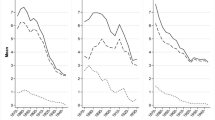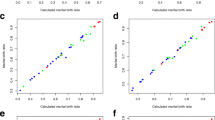Abstract.
In this paper it is argued that models for completed fertility have to take into consideration that childless couples and couples with an only child are qualitatively different from couples with two or more children. Indeed, these differences may be the cause of the underdispersion that characterizes completed fertility data. An empirical illustration using Portuguese data suggests that accounting for the qualitative difference between having zero, one, or more children leads to considerable improvements over a model of the type generally used to describe this sort of data.
Similar content being viewed by others
Author information
Authors and Affiliations
Additional information
Received: 6 July 1998/Accepted: 14 January 1999
Rights and permissions
About this article
Cite this article
Santos Silva, J., Covas, F. A modified hurdle model for completed fertility. J Popul Econ 13, 173–188 (2000). https://doi.org/10.1007/s001480050132
Issue Date:
DOI: https://doi.org/10.1007/s001480050132




